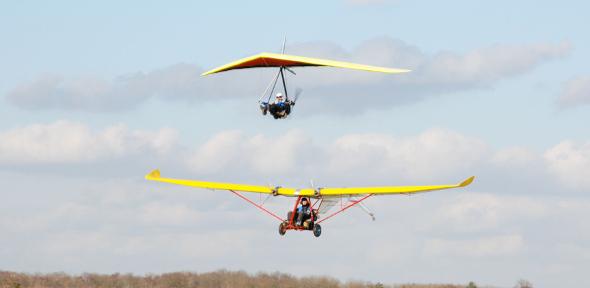
These are the first electric aircraft to fly in the UK under the recently introduced sub-115 kg regime, which allows single seat, lightweight aircraft to be developed and flown without the administrative burden of the airworthiness approvals process applied to larger aircraft. This class was introduced to encourage innovation in light aviation in the UK.
The electric propulsion system for the twin-engine, fixed-wing Lazair airframe of Canadian origin was designed and built by Dr Paul Robertson of the Engineering Department, in collaboration with Paul Dewhurst of Flylight Airsports Ltd, a Midlands based manufacturer and importer of microlight aircraft. The hang-glider (flex-wing) based Dragonfly trike unit, made by Flylight, was powered by an electric motor system being developed in Germany. The electric aircraft have flown for around 30 minutes on a single charge, reaching an altitude of 1700 ft.
The E-Lazair propulsion system comprises a pair of 10 kW peak, brushless electric motors, weighing less than 2 kg each, with direct drive to carbon fibre propellers. The motors are each powered by a stack of 12 large capacity (40 Ah) Lithium Polymer (LiPo) cells, giving a total stored energy capacity of 3.2 kWh. A bespoke Battery Management System (BMS), charger unit and avionics were developed by Dr Paul Robertson to monitor the energy capacity and temperature of the LiPo cells, control the motor power and temperature and provide the pilot with a 'fuel gauge' to indicate remaining capacity. Each of the 24 LiPo cells are individually monitored and charge balanced to maintain optimum capacity and cell lifetime.
These developments are the first steps towards a new class of leisure aircraft offering low operating costs, high reliability and low environmental impact - on both carbon footprint and noise issues. Observers on the ground commented on the very low noise levels and the pilots noticed a significant decrease in both noise and vibration, when compared to petrol engine alternatives.
Flight tests using the existing Lazair airframe will continue, to characterise and develop the electric propulsion system, although substantial increases in the flight duration and range can only be achieved through a custom-built airframe, encompassing the new design opportunities available through electric propulsion. These will include such factors as being able to distribute the mass of the propulsion units and energy storage around the airframe - there is no longer a need for a relatively large, heavy engine in one location, with its attendant structural bracing adding yet more weight. The potential of hybrid fuel options are also being considered. A flight duration of 2 hours and a range of 100 miles are being targeted and sponsorship is being sought to help achieve these objectives.

